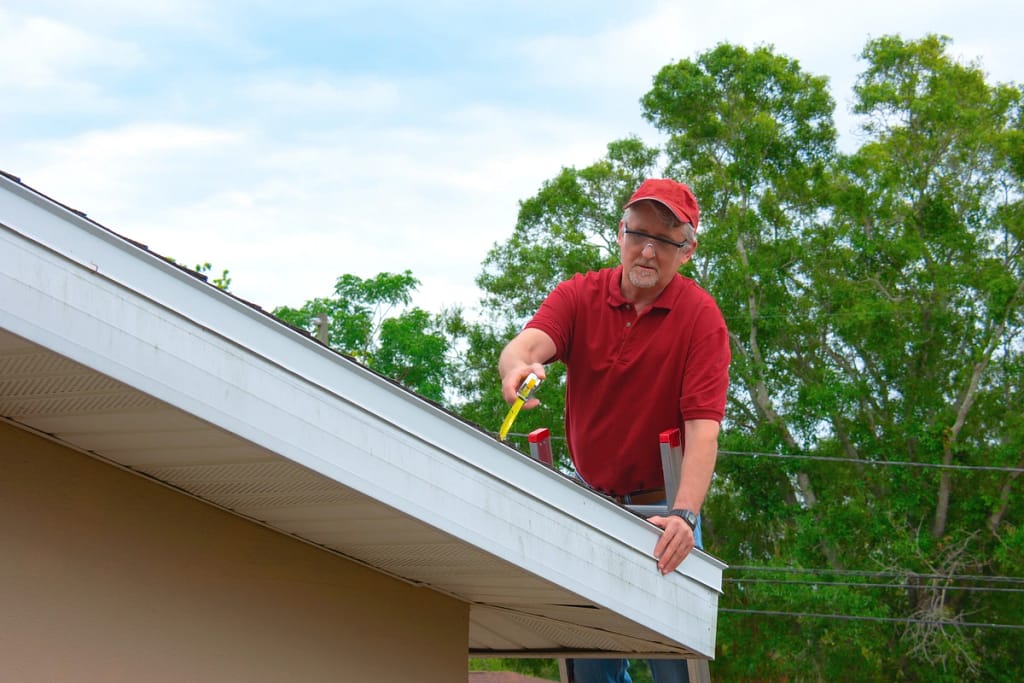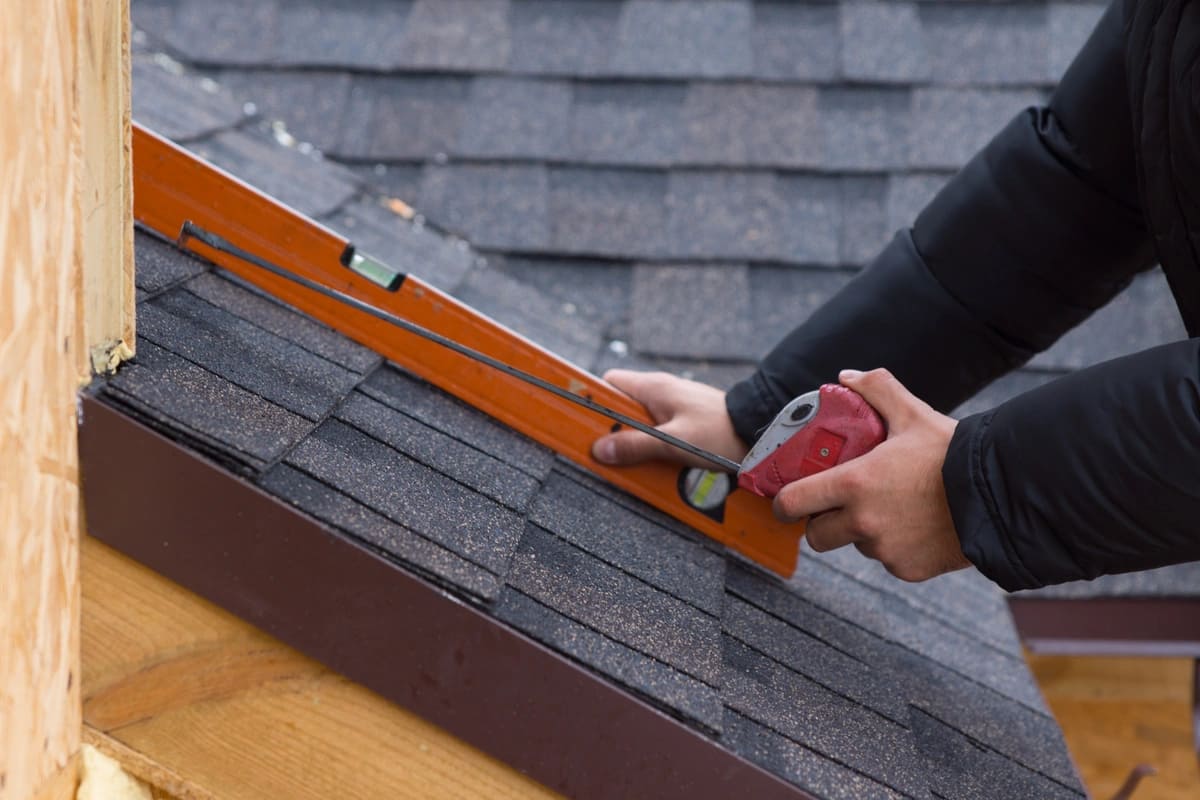Your roof keeps you and the structure of your home safe day in and day out. Over time, wear and tear become inevitable, necessitating roof replacement.
However, before embarking on this project, it’s imperative to measure your roof accurately, especially when opting for shingles. If you’re wondering how to measure a roof for shingles, you’ve come to the right place!
In this guide, we’ll help you understand:
- The intricacies of roof measurement for shingle installation
- Signs indicating a roof replacement is necessary
- The debate between DIY and professional services
Signs That You Need to Replace Your Roof

Before measuring your roof for shingles, it’s essential to recognize the signs indicating the need for replacement. Ignoring these signs can lead to more significant issues down the road, including water damage and compromised structural integrity. Look out for:
- Age: If your roof is nearing the end of its expected lifespan, typically 20-30 years for asphalt shingles, it’s time to consider replacement.
- Missing or Damaged Shingles: Shingles that are cracked, curled, or missing altogether leave your roof vulnerable to leaks and water damage.
- Water Stains on Ceilings: Interior water stains are a clear indication of roof leaks, signaling that your roof’s protective barrier has been compromised.
- Sagging Roof Deck: A sagging roof deck suggests structural damage, often caused by water infiltration and rot.
- Granules in Gutters: Excessive granule loss from shingles indicates advanced wear and may necessitate replacement to maintain roof integrity.
The Benefits of Choosing Asphalt Shingles for Your Roof
Among the various roofing materials available, shingles remain a popular choice for homeowners due to their numerous benefits:
- Affordability: Shingles are cost-effective compared to other roofing materials, making them an attractive option for budget-conscious homeowners.
- Versatility: Available in a wide range of colors and styles, shingles offer versatility, allowing homeowners to choose a design that complements their home’s aesthetic.
- Durability: High-quality shingles can withstand harsh weather conditions, providing long-lasting protection for your home.
- Ease of Installation: Shingle installation is relatively straightforward, making it an ideal choice for DIY enthusiasts or those looking to minimize labor costs.
- Energy Efficiency: Some shingles are designed to reflect solar heat, reducing energy consumption and lowering utility bills.
Why You Need to Carefully Measure Your Roof

Accurate roof measurement is crucial to ensure you purchase the correct amount of shingles and avoid costly errors during installation. Here’s why precision matters:
Cost Savings 💵
Overestimating or underestimating the amount of shingles needed can result in unnecessary expenses or delays in completing the project.
Proper Coverage ✅
Insufficient shingle coverage leaves your roof vulnerable to leaks and water damage, compromising its integrity.
Waste Reduction ♻️
Precise measurements minimize material waste, maximizing the value of your investment and reducing environmental impact.
Safety 🦺
Accurate measurements enable you to plan for any necessary safety equipment and precautions during installation, reducing the risk of accidents or injuries.
How to Measure Your Roof for Shingles: 5 Steps
Measuring your roof for shingle installation requires attention to detail and a systematic approach. Follow these steps for accurate measurements:
1) Determine Roof Pitch:
Roof pitch, or slope, influences the amount of material needed for installation. Use a pitch gauge or consult with a professional to determine the pitch of your roof.
2) Calculate Roof Area:
Break down your roof into manageable sections, such as rectangles or triangles, and measure each section’s length and width. Multiply the length by the width to calculate the area of each section, then sum the areas to determine total roof area.
3) Account for Overhangs and Wastage:
Add extra material to account for overhangs, waste during installation, and any potential errors in measurement. Industry standards typically recommend adding 10% to 15% to your total area to accommodate these factors.
4) Consider Roof Features:
Take into account any roof features, such as dormers, chimneys, or skylights, which may require additional materials and labor for proper installation.
5) Choose Shingle Size and Type:
Select the appropriate shingle size and type based on your roof’s dimensions, pitch, and aesthetic preferences. Consult with a roofing professional for guidance if needed.
When to Leave It to a Professional
While DIY projects can be rewarding, certain aspects of roof replacement are best left to trained professionals. Consider hiring a roofing contractor if:
- Safety Concerns: Working at heights poses inherent risks, and inexperienced individuals may lack the necessary safety equipment and training to navigate potential hazards safely.
- Complex Roof Designs: Roofs with intricate designs, multiple angles, or unusual features require specialized knowledge and skills to ensure proper installation and waterproofing.
- Warranty Requirements: Many shingle manufacturers require professional installation to validate warranty coverage, protecting your investment in case of defects or issues.
- Time Constraints: Professional roofers have the expertise and resources to complete the job efficiently, minimizing disruptions to your daily life and ensuring timely completion.
- Code Compliance: Roofing professionals are familiar with local building codes and regulations, ensuring that your roof replacement meets all necessary requirements for safety and legality.
DIY Roof Replacement vs. Hiring a Professional
The decision between DIY roof replacement and hiring a professional ultimately depends on various factors, including your skill level, budget, and time constraints. Consider the following benefits of each approach:
DIY Roof Replacement
- Cost Savings: DIY roof replacement can save you money on labor costs, especially if you’re proficient in basic carpentry and roofing techniques.
- Personal Satisfaction: Completing a DIY project can be immensely satisfying and rewarding, providing a sense of accomplishment and pride in your home.
- Flexibility: DIY allows you to work at your own pace and schedule, accommodating other commitments and priorities. Cons:
- Safety Risks: DIY roofing poses significant safety risks, including falls, injuries from tools, and exposure to hazardous materials such as asbestos or mold.
- Lack of Experience: Inexperienced individuals may struggle with complex tasks, leading to errors in measurement, installation, or waterproofing.
- Time and Effort: Roof replacement is a labor-intensive process that requires time, effort, and attention to detail. DIYers may underestimate the time and resources needed to complete the project successfully.
Hiring a Professional
- Expertise and Experience: Professional roofers have the skills, knowledge, and experience to tackle even the most challenging roof replacement projects, ensuring quality workmanship and long-lasting results.
- Warranty Coverage: Many roofing contractors offer warranties on their workmanship, providing peace of mind and protection against defects or issues that may arise after installation.
- Time Savings: Hiring professionals streamlines the process, allowing you to avoid the time-consuming tasks of procurement, preparation, and cleanup associated with DIY projects. Cons:
- Higher Cost: Professional roof replacement typically incurs higher upfront costs than DIY, reflecting labor fees, overhead expenses, and profit margins.
- Limited Control: Entrusting your roof replacement to professionals means relinquishing some control over the process and relying on their expertise and judgment.
- Scheduling Constraints: Depending on the availability of contractors and weather conditions, scheduling roof replacement may require flexibility and patience.
Let Us Handle Your Roofing Project
Measuring your roof accurately is a crucial step in the roof replacement process, particularly when installing shingles. If you’re ready to learn more about your roof’s surface area, but want a professional opinion, Best Exteriors is ready to help! Contact us today to find out the total square footage of the roof of your home!




